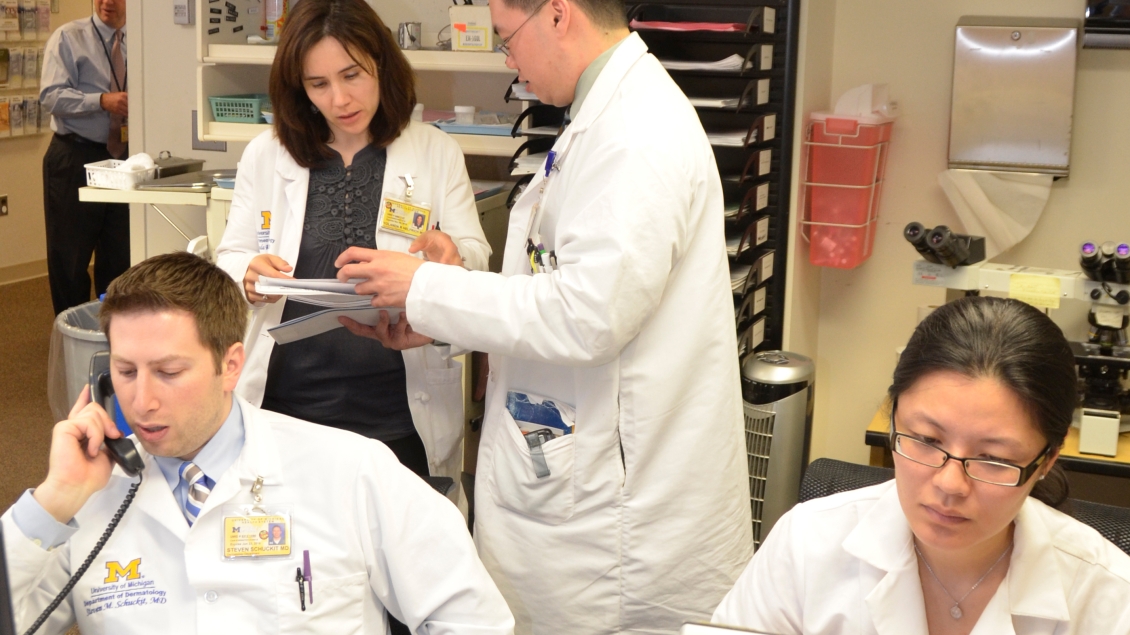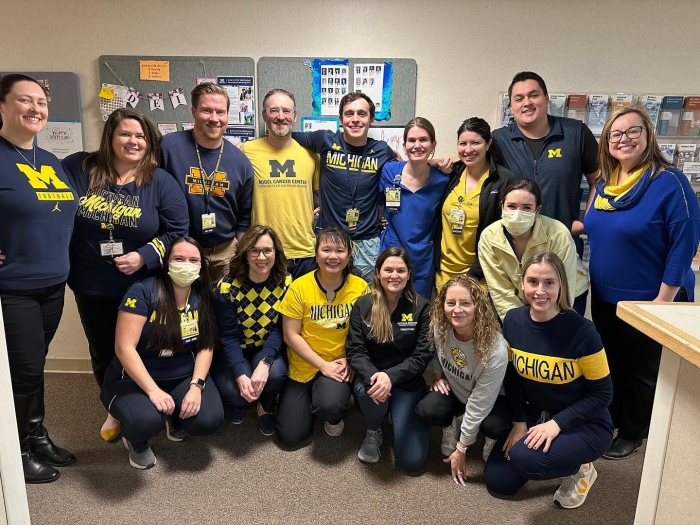
Residents rotate through an abundance of services and clinics during their time at Michigan. Most rotations occur in one-month or 6-week blocks. Each month is split in half (12 months per year—24 ½-month rotations), with residents changing assignments on the 1st and 16th of each month. A sample block schedule is below.
| Training | 1 | 2 | 3 | 4 | 5 | 6 | 7 | 8 | 9 | 10 | 11 | 12 |
| 1st year | Clinic | VA | DermPath | CONS | Clinic | VA | Peds | Peds | DTC/Patch | MEL | Clinic | VA |
| Clinic | VA | Clinic | Clinic | Clinic | VA | Peds | DTC/Patch | DTC/Patch | MEL | Clinic | VA | |
| 2nd year | Clinic | Mohs | VA | Clinic | CDLC | CONS | CONS | VA | MEL | UHS | UHS | DermPath |
| Mohs | Mohs | VA | Clinic | CDLC | CONS | Clinic | VA | MEL | UHS | DermPath | DermPath | |
| 3rd year | VA | Clinic | Clinic | MEL | Clinic | Clinic | VA | Clinic | Elective | VA | Clinic | Clinic |
| Va | Clinic | Clinic | MEL | Clinic | Clinic | VA | Clinic | Elective | VA | Clinic | Clinic |
- CDLC: Cosmetic Dermatology & Laser Center
- Clinic: Primarily Taubman Center or Domino's Farms Clinics
- CONS: Inpatient consult service
- DermPath: Dermatopathology
- DTC/Patch: Dermatology Treatment Center and patch testing
- Elective: Elective
- MEL: Melanoma/Merkel cell
- Mohs: Mohs/Cutaneous Surgery & Oncology
- Peds: Pediatric Dermatology Clinic
- UHS: University Health Service
- VA: Veterans Affairs Healthcare System
We invite residents to volunteer at our dermatology community outreach clinic, hosted one Saturday morning each quarter at our Taubman Center clinic. Our Hope Clinic volunteer physicians deliver dermatology specialty care to patients who are uninsured or under-insured, in coordination with the Hope Clinic, a regional free clinic.
Each resident has a dedicated continuity clinic every other week. Residents are encouraged to schedule patients into their own clinic for continuity of care. The goal is for residents to follow patients with both common and complex dermatologic conditions longitudinally over time.
Residents rotate through our Cosmetic Dermatology and Laser Center (CDLC) working closely with Dr. Jeffrey Orringer, learning about cosmetic dermatology. Residents learn how to perform cosmetic consultations and cosmetic procedures, including multiple types of ablative and non-ablative laser procedures (treatment of vascular lesions, pigmented lesions, unwanted tattoos and hair, resurfacing for scars and wrinkles, and more), sclerotherapy, non-invasive body sculpting, chemical peels, neurotoxin and soft tissue filler injections, and platelet rich plasma injections. Residents gain hands on experience with neurotoxin and filler injections, and laser treatments as well.
Proficiency in interpretation of histologic sections of the skin and an understanding of laboratory procedures is important and required of dermatology residents. In addition to a robust didactic curriculum in dermatopathology, with weekly textbook assignments and weekly unknown slide sessions, residents spend time at the scope with dermatopathology faculty reading slides.
Senior residents have one month of elective time. Residents can use this time to do additional training in procedural dermatology or dermatopathology, to pursue research projects and write papers, or to spend time with other services in the hospital. Residents have rotated on the inpatient rheumatology service, spent time in vulvar clinics, and observed hair transplants.
The bulk of each resident’s time is spent in general and complex dermatology. Our two main clinical sites are the Taubman Clinic, located on the main medical campus, and the Domino's Farms Clinic, located approximately 5 miles from main campus on the north side of town.
Clinics at Taubman are a mix of specialty and general dermatology clinics. As a large referral center, residents gain familiarity with diagnosis and treatment of both common and rare dermatologic conditions. Clinics at Domino's Farms are general dermatology clinics and resident continuity clinics.
As a senior resident, house officers spend 6 weeks managing our inpatient consult service. Supervised by Dr. Severine Cao, Dr. Sara Fossum, and Dr. Jennie Mancuso, this busy service receives up to 10 new consults each day. Residents become comfortable managing the most challenging and complex dermatologic cases and work as hospital-based teams with other services to manage these patients. Junior residents spend two weeks in the first year assisting the senior resident and learning how to approach inpatient care to prepare for their own consults rotation.
House officers are able to submit proposals to our institutional GME office to seek approval for off-site or Global Dermatology rotations. Our Global Dermatology Program supports a resident during a one month rotation at a Global REACH partner institution (e.g., international locations in India and China). This international rotation aims to broaden the clinical training experience and achieves Michigan Medicine’s broader mission to advance health to serve Michigan and the world. Our Global Dermatology Program also supports resident and faculty interest in use of technology to expand access to dermatology expertise throughout the world.
Pediatric patients comprise more than 20% of our nearly 40,000 outpatient general dermatology visits each year. Residents gain an appreciation of the age-related variations in disease and disorders specific to children, as well as pediatric dermatology problems in the context of general dermatology. Our pediatric dermatology clinic is led by fellowship-trained pediatric dermatologists, Dr. Jennifer Mancuso and Dr. Cynthia Nicholson.
During this rotation, residents manage patients receiving modified Goeckerman therapy in our Day Treatment Center (DTC), supervised by Dr. Frank Wang. Michigan Medicine is one of the few institutions in the country which provides modified Goeckerman therapy—the use of tar, topical steroids, and phototherapy to provide rapid relief to patients suffering from extensive skin disease.
After rounding on patients in the DTC, residents work with Dr. Bonita Mathai in our contact dermatitis clinic, learning about evaluation of patients with potential contact allergy and learning how to perform and interpret patch testing.
- Alopecia Clinic: led by faculty member Dr. Yolanda Helfrich, residents evaluate and treat patients with hair loss and other hair disorders. Residents learn to evaluate, diagnose and manage multiple causes of hair loss, including alopecia areata, central centrifugal cicatricial alopecia (CCCA), male and female patterned hair loss, frontal fibrosing alopecia and lichen planopilaris, telogen effluvium and other less common etiologies of hair loss and hair thinning.
- Comprehensive Skin Cancer Clinic: led by faculty members Dr. Trilok Tejasvi and Dr. Yolanda Helfrich, residents examine and treat patients at higher risk for skin cancer. Residents become proficient at using dermoscopy to examine patients with difficult skin exams.
- Cutaneous Lymphoma Clinic: led by faculty member Dr. Trilokraj Tejasvi, residents gain an understanding of cutaneous lymphoma, and become comfortable with the diagnosis, multidisciplinary care, and treatment of this condition.
- Follicular Disorders Clinic: led by faculty members Dr. Jennie Mancuso and Dr. Sara Fossum, residents evaluate and treat patients with a range of follicular disorders, including hidradenitis suppurativa, dissecting cellulitis, folliculitis decalvans, and acne vulgaris. Residents learn to manage these medically complex patients as well as perform in office procedures including intralesional Kenalog and de-roofing procedures.
- Immunobullous Disorders Clinic: led by faculty members Dr. Anj Dlugosz and Dr. Sara Fossum, residents learn to manage diseases such as pemphigus and pemphigoid. Residents graduate feeling very comfortable diagnosing these conditions and managing medications such as mycophenolate, rituximab, methotrexate, and cyclosporine.
- Multidisciplinary Cutaneous Oncology Program: The U-M Multidisciplinary Cutaneous Oncology Program is one of the largest dermatology-based clinical programs in the United States, with approximately 1,200 new patient consultations per year. Residents learn about evaluation techniques, clinical findings, staging, sentinel lymph node biopsies, and therapies for melanoma skin cancer and other more rare cutaneous malignancies, such as merkel cell carcinoma. Residents participate in multidisciplinary tumor board meetings to develop consensus treatment recommendations for patients requiring multispecialty care.
- Nail Disorders Clinic: led by faculty member Dr. Julie Mervak, residents evaluate and treat patients with a range of nail diseases. Residents learn to evaluate and determine if the nail findings are an isolated diagnosis or related to systemic disease. Commonly seen conditions include onychomycosis, nail psoriasis, nail lichen planus, melanonychia, and nail tumors.
- Pediatric Dermatology Clinic: led by faculty members Dr. Jennie Mancuso and Dr. Cynthia Nicholson, residents evaluate and treat pediatric dermatology patients. Residents become comfortable managing propranolol in infants with hemangiomas and performing skin biopsies and other procedures in children
- Skin of Color Clinic: led by Dr. Severine Cao and located at the U-M Ypsilanti Health Center, residents learn to diagnose and manage dermatologic disorders affecting patients with melanated skin.
*Additional Specialty Clinics: we are planning for additional specialty clinics in the upcoming year, including Inflammatory Dermatoses Clinic and Integrative Dermatology Clinic.
Our program offers many opportunities for hands-on surgical training. Residents spend 6 weeks on our Mohs surgery rotation learning how to perform Mohs surgery and complex repairs from our fellowship-trained Mohs surgeons. PGY-3 residents rotate through the Resident Procedure Clinic, performing excisions under the supervision of Dr. Kelly Cha at Domino Farms on Thursdays. As a PGY-4, residents rotate through the Friday Resident Procedure Clinic, also staffed by Dr. Kelly Cha at Domino's Farms.
There are many opportunities to gain surgical experience at our VA as well. Residents at all levels participate in weekly surgery clinics while rotating at our VA (7-8 months over the course of residency).
Senior residents spend 6 weeks practicing as independent providers at our University Health Service. Faculty remain on-call to provide remote advice and supervision. In this setting, residents are able to gain additional continuity experience in a low-intensity, multispecialty group practice providing dermatologic care to students, staff, and faculty associated with the University of Michigan.
Our residency program offers a robust VA experience, where residents spend a total of 8 months of their training. Residents see general dermatology patients and also have multiple surgery clinics at the VA, working not only with dermatology surgeons, as well as with ENT and plastic surgeons. Senior residents assigned to the VA become skillful at practicing teledermatology, utilizing store-and-forward clinical and dermoscopic images to provide treatment recommendations to distant VA sites.
Our VA recently purchased a confocal microscope, giving our residents the opportunity to learn how to utilize this new technology. In 2024, Dr. Castanedo-Tardan will be starting to perform Mohs surgery at the VA.
Many residents choose to pursue research projects over the course of their residency. Dermatology residents are encouraged to collaborate with clinical faculty to develop clinical case reports and case reviews, retrospective studies, and clinical research projects.

Follow Michigan Dermatology Residency on Instagram for the latest stories, photos and more.
I chose the University of Michigan due to its long standing reputation for developing world renowned dermatologists and its commitment to building a strong foundation for all of its residents. I graduated feeling confident in my skills and specifically having a strong knowledge base in medical dermatology differentiates me from other aesthetic providers. I cannot speak more highly of the program and am proud to be a graduate.
